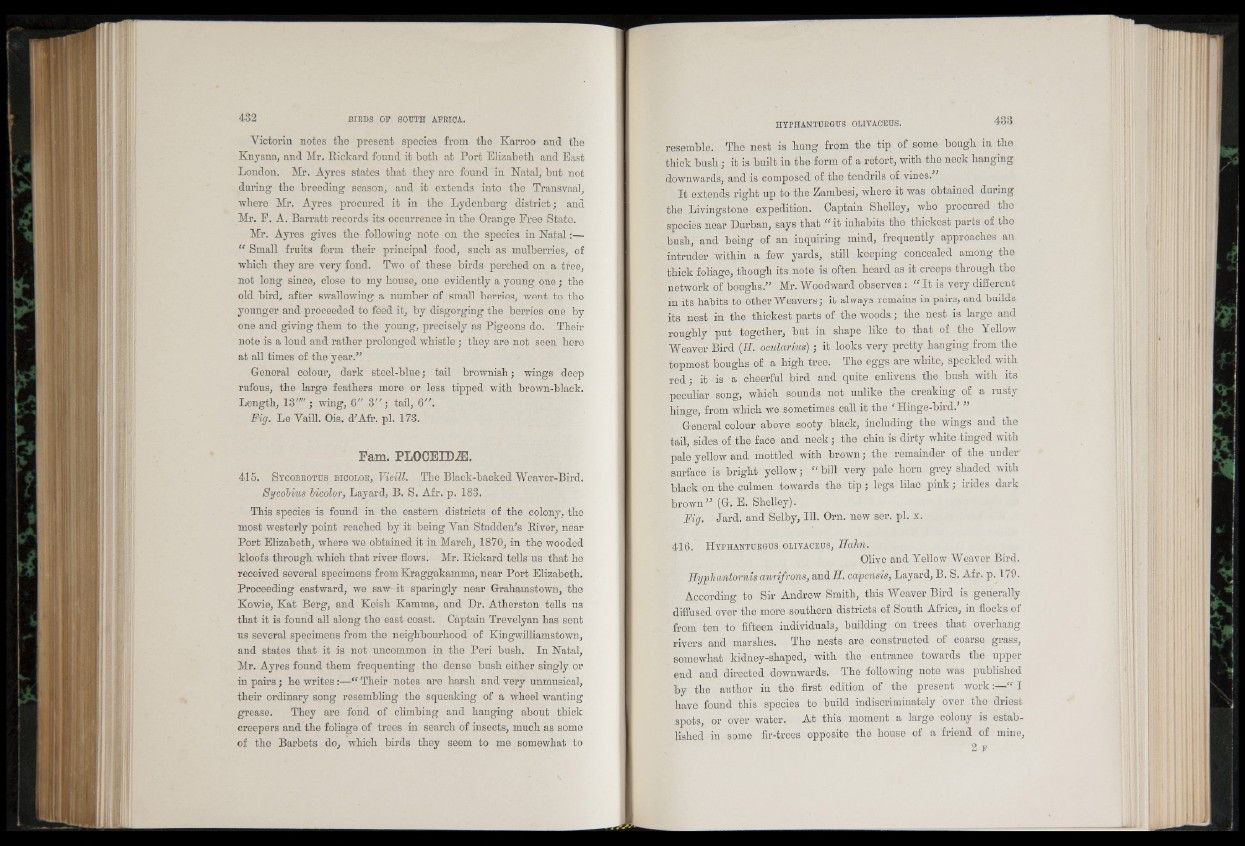
Yictorin notes the present species from the Karroo and the
Knysna, and Mr. Rickard found it both at Port Elizabeth and East
London. Mr. Ayres states that they are found in Natal, but not
during the breeding season, and it extends into the Transvaal,
where Mr. Ayres procured it in the Lydenburg district; and
Mr. P. A. Barratt records its occurrence in the Orange Free State.
Mr. Ayres gives the following note on the species in Natal:—
“ Small fruits form their principal food, such as mulberries, of
which they are very fond. Two of these birds perched on a tree,
not long since, close to my house, one evidently a young one; the
old bird, after swallowing a number of small berries, went to the
younger and proceeded to feed it, by disgorging the berries one by
one and giving them to the young, precisely as Pigeons do. Their
note is a loud and rather prolonged whistle ; they are not seen here
at all times of the year.'’5
General colour, dark steel-blue; tail brownish; wings deep
rufous, the large feathers more or less tipped with brown-black.
Length, 13"" ; wing, 6" 8"-; tail, 6".
Fig. Le Yaill. Ois. d’Afr. pi. 173.
Fam. PLOCEIDiE.
415. S ycobrotus bicolor, Vieill. The Black-backed Weaver-Bird.
Sycobius bicolor, Layard, B. S. Afr. p. 183.
This species is found in the eastern districts of the colony, the
most westerly point reached by it being Yan Stadden’s River, near
Port Elizabeth, where we obtained it in March, 1870, in the wooded
kloofs through which that river flows. Mr. Rickard tells us that he
received several specimens from Kraggakamma, near Port Elizabeth.
Proceeding eastward, we saw it sparingly near Grahamstown, the
Kowie, Kat Berg, and Keish Kamma, and Dr. Atherston tells us
that it is found all along the east coast. Captain Trevelyan has sent
us several specimens from the neighbourhood of Kingwilliamstown,
and states that it is not uncommon in the Peri bush. In Natal,
Mr. Ayres found them frequenting the dense bush either singly or
in pairs; he writes :—“ Their notes are harsh and very unmusical,
their ordinary song resembling the squeaking of a wheel wanting
grease. They are fond of climbing and hanging about thick
creepers and the foliage of trees in search of insects, much as some
of the Barbets do, which birds they seem to me somewhat to
resemble. The nest is hung from the tip of some bough in the
thick bush j it is built in the form of a retort, with the neck hanging
downwards, and is composed of the tendrils of vines.
It extends right up to the Zambesi, where it was obtained during
the Livingstone expedition. Captain Shelley, who procured the
species near Durban, says that “ it inhabits the thickest parts of the
bush, and being of an inquiring mind, frequently approaches an
intruder within a few yards, still keeping concealed among the
thick foliage, though its note is often heard as it creeps through the
network of boughs.” Mr. Woodward observes : “ It is very different
in its habits to other Weavers; it always remains in pairs, and builds
its nest in the thickest parts of the woods; the nest is large and
roughly put together, but in shape like to that of the Yellow
Weaver Bird {H. ocularius) ; it looks very pretty hanging from the
topmost boughs of a high tree. The eggs are white, speckled with
red ; it is a cheerful bird and quite enlivens the bush with its
peculiar song, which sounds not unlike the creaking of a rusty
hinge, from which we sometimes call it the ‘ Hinge-bird.’ ”
General colour above sooty black, including the wings and the
tail, sides of the face and neck; the chin is dirty white tinged with
pale yellow and mottled with brown; the remainder of the under
surface is bright yellow; “ bill very pale horn grey shaded with
black on the culmen towards the tip ; legs lilac pink; irides dark
brown” (G. E. Shelley).
Fig. Jard. and Selby, 111. Orn. new ser. pi. x.
4 1 6 . H yphanturgus olivaceus, Hahn. Olive and Yellow Weaver Bird.
Hyphaniornis au-rifrons, and H. capensis, Layard, B. S. Afr. p. 179.
According to Sir Andrew Smith, this Weaver Bird is generally
diffused over the more southern districts of South Africa, in flocks of
from ten to fifteen individuals, building on trees that overhang
rivers and marshes. The nests are constructed of coarse grass,
somewhat kidney-shaped, with the entrance towards the upper
end and directed downwards. The following note was published
by the author in the first edition of the present work:—“ I
have found this species to build indiscriminately over the driest
spots, or over water. At this moment a large colony is established
in some fir-trees opposite the house of a friend of mine,
2 f